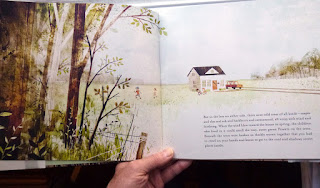My rating: 5 of 5 stars
Ted Kooser’s beautiful history of a house is in someways reminiscent of Virginia Lee Burton’s “The Little House,” but unlike that book, Kooser doesn’t anthropomorphize his house or try to imbue it with human feelings.
In telling his story of a house from the time when it was new to its rebirth as a house held up by trees, Kooser, a former U.S. Poet Laureate uses language that is evocative but at the same time wistful. Like in Burton’s “The Little House,” the house in this story is the main character, the humans are secondary and they come and go. In the beginning we see the house when it is new, being cared for and loved by a man and his two children. Set in a clearing between two wooded lots, the house’s owner keeps the grounds immaculate, uprooting any seedlings that pop up in his perfect lawn. But as the years pass, the children move away and eventually so does their father. Sitting unsold, the house falls into disrepair. As time passes, seedlings and saplings pop up around it, hugging the house and protecting it from the winds. One day the trees, whose roots and branches have held the house together, begin to lift the house up toward the sky, where it is reborn as a house held up by trees. Jon Klassen’s digital and gouache illustrations are the perfect compliment for this somewhat melancholic story. Many of the illustrations are double-page spreads that give us wide panoramic vistas that emphasize the house’s isolation in the landscape. In two spreads early in the story we see the house as it looks from the point of view of the woods. We glimpse it through tree branches and see it sitting in the distance. It’s a clever foreshadowing of later illustrations where we will once again see the house through tree branches, the difference being that in the later illustrations we are up close to the house, with it looming large in the frame and the trees we are looking through are the ones that “held it together as if it was a bird’s nest in the fingers of their branches.”
As I mentioned, there are human characters in the story, but we never learn their names. We get glimpses of them from a distance or from behind, but we never see their faces. There are several haunting illustrations in this story that tugged at my heartstrings. In one, the two now grown children are shown from behind looking at the woods next to the house, a place where they use to run and play. It’s also a place where they would sit in the shadows and watch their father as he worked on his lawn. On the left side of the illustration are the woods, cool and inviting and unchanged from their childhood. On the right side, we see the adult children, the man holds a baseball cap at his side, while the woman holds a leaf. For me, these two details - a baseball cap and a leaf convey the melancholy of growing older. The only thing we can hold on to from our childhood are our memories and a few small mementoes, we must let go of everything else.
In another panoramic illustration, we see the father sitting in a folding chair, watching the sunset. The text tells us he is older now and his grown children "were gone for good . . ." Next to the father, is an empty chair. On the left side of the spread we see through a window into the house's dining room where we get a glimpse of a lone place setting. Leaning against the outside of the house is the man’s lawnmower. Tall grass is starting to grow around it and even without the information in the text, we know that the man has given up on trying to keep up his lawn. It’s an illustration suffused with loneliness.
I loved this book. It was published by Candlewick, a publisher that seems to strive to put out beautiful books. This one is no exception. The language, illustrations and story are all beautiful. Having said that, I was somewhat surprised to see a publisher put out a children’s book that has no strong characters for children to identify with. It seems very much a book that will appeal more to adults looking back wistfully on their lost childhoods, then it will to most children. Maybe that's why I liked it so much. But I do hope that children will read this and love it. Those who do will be rewarded by a book that demonstrates the passage of time and what it means to grow older. Though there is a tone of loneliness in the book, there is also a comforting message of rebirth. I checked this book out from our public library, but it’s one that I fell in love with so I know I’ll be buying a copy for myself.
The illustrations below are by Jon Klassen from Ted Kooser's "House Held Up By Trees."
 |
| One of the panoramic two page spreads showing the house near the forest |
 |
| Detail showing the house as it looks from the woods |
 |
| A detail showing the father sitting alone on his perfect lawn |
 |
| The now derelict house, sits alone, but the saplings are starting to surround it. |
View all my reviews

